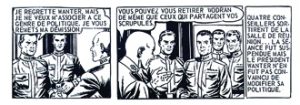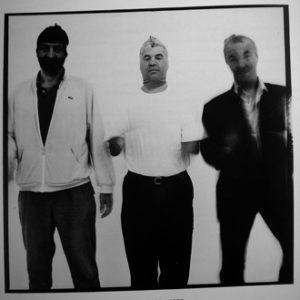
Katia Schneller recently defended an excellent dissertation on the constructions and deconstructions of artistic categories in New York between 1966 and 1973. In her thesis, Schneller described the proliferation of all kinds of labels, from Minimal Art to Postminimalism, passing by way of Conceptual Art and the Anti-Form movement. Such labels offer less an account of clear categories of new artistic practices than an understanding of how the notion of style was being redefined. This way of mimicking the breaks made by various avant-garde movements has served as a prelude to the situation we have today, where the attribution of names corresponds to an attempt to define the nature of artistic activity. The project of Vanessa Théodoropoulou and Tristan Tremeau here is to study what is covered by such nominalism.
Laurence Bertrand Dorléac
Collective Nominalism
Vanessa Théodoropoulou
“Every lament is always a lament for language, just as all praise is principally praise of the name.” — Giorgio Agamben, The Coming Community, 1990.

Fig. 1 Detourned comic, Internationale Situationniste, 5 (December 1960): 4.
Two years after the “nominal” constitution of their movement, on July 28, 1957[ref]See G.-E. Debord, “Encore un effort si vous voulez être situationnistes,” Potlatch, 9 (November 5, 1957), reprint edition: Paris: Allia, Paris, 1996, p.143 (emphasis added); “One More Try If You Want to Be Situationists,” trans. John Shepley: http://www.cddc.vt.edu/sionline/si/onemore.html [/ref],, the Situationists declared in the pages of their review. “The SI is a very particular movement, of a different nature than preceding artistic avant-gardes. On the level of culture, the SI can for example be compared to a research laboratory, and also a [political] party. . . . Situationist activity is a definite trade that we still do not ply. . . . Thus, since we cannot at all represent a communal style of any kind, the signature of the movement, the trace of its presence and its contestation in the cultural reality of today is above all the use of detournement.”[ref]See “Le détournement comme négation et comme prélude,” in Notes éditoriales, Internationale Situationniste, 3 (December 1959): 10-11 (pp. 78-79 of the reprint edition); “Detournement as Negation and Prelude,” translated from the French and footnoted by NOT BORED!: http://www.notbored.org/detournement.html (translation slightly altered).[/ref]
This brief excerpt, which is revelatory of the group’s intentions vis-à-vis language[ref]It is emblematic, too, in its opposition to “separate” work (specialization, alienation). “Situationist activity” signifies the idea of a “unitary” world view and praxis, therefore a world view and praxis applicable in all domains of life.[/ref] (definition as a game among antagonistic players), confirms the deliberately “mythical” nature of the name of this coalition. Following the definition of myth established by Roland Barthes shortly before the SI’s formation,[ref]Roland Barthes, “Myth Today,” in Mythologies (1957), selected and translated from the French by Annette Lavers (London: Vintage, 1993).[/ref] the “Situationist International” (1957-1972)–which, according to the will of its founders, became a veritable legend[ref]Guy Debord, Letter to Asger Jorn, September 1, 1957, in Correspondance, vol. 1 (Paris: Fayard, 1999), p. 24; translated from the French by NOT BORED!: http://www.notbored.org/debord-1September1957.html.[/ref] –would at the outset be only a “form” containing a “historical” concept. The historical concept in question, which was unique and therefore a real tie among its members, was the idea of a “communal action of free individuals, tied only by and for this real creative liberty,”[ref]Guy Debord, Letter to Patrick Straram, November 12, 1958, in Correspondance, vol.1, pp. 158-59 (emphasis added); translated from the French by NOT BORED!: http://www.notbored.org/debord-12November1958.html.[/ref] and its formation (or “situating”) was a first application of its preferred artistic practice. The fulfilment of the SI project[ref]The dialectical “overcoming” of art and politics from a “total” perspective–that is to say, relative to behaviors and relationships.[/ref] would, as a consequence, coincide with that of its name, the latter being the representation of the Situationist movement’s ideas as well as of its style.
Toward a Problematization of Categories

Fig. 2 Photo illustrating the report on the Fifth Conference of the Situationist International in Göteborg (August 18-30, 1961), in Internationale Situationniste, 7 (April1962): 30; the legend reads: “At the end of the Göteborg Conference, some Situationists fraternize with Swedish workers.”
The case of the SI is emblematic of the conceptual turning point in collective artistic identities that marked the 1950s, when these collective artistic identities were progressively transformed into nominal identities. The SI case has the merit of highlighting an often overlooked observation: each generic name designed to designate a shared creative activity is in itself an attempt to define the nature of the activity envisaged. A critical rereading of the various -isms, movements, schools, collectives, labels, cooperatives, “business enterprises,” and other artistic configurations that have appeared on the public scene since the beginning of the twentieth century brings out a highly varied set of aesthetic and/or ideological intentions. As a result of this reading, the groupings we find in dictionaries become merely rough and approximative while narratives of art history are themselves rendered, to say the least, problematic. It turns out that even the use of such a leading historical category as the avant-garde (and its distorted reflection, the neo-avant-garde) becomes increasingly arbitrary, inasmuch as a thoroughgoing investigation into the history of its uses has not been performed.[ref]Despite the rich bibliographical sources that exist on the topic of avant-garde movements, it seems to us that, apart from reference works by Peter Burger (Theory of the Avant-Garde, trans. Michael Shaw [Minneapolis: University of Minnesota Press, 1994]) and Hal Foster’s response (The Return of the Real: The Avant-Garde at the End of the Century [Cambridge, MA and London: The MIT Press, 1996]) or the highly useful investigation coordinated by Jean Weisgerber, ed. (Les avant-gardes littéraires au XXe siècle, vol. 1: Histoire, vol. 2, Théorie [Brussels: Le Centre d’études des avant-gardes littéraires de l’Unversité de Bruxelles, 1975]), what is lacking is a real research work on the history of this notion and its various strategic usages by the various agents of modern art: artists, theorists, or performers. [/ref] Categorization is an often necessary but ever delicate operation, one that the historian should, it seems to me, regularly call into question, the better to grasp the various aesthetic and political (formal and ideological) stakes of art in each era.
One Name Isn’t as Good as Another
For, if the act of naming is already highly significant in the case of artists from the first half of the twentieth century, the postwar context renders such an undertaking more complex. Let us recall, by way of examples, the legend surrounding the name Dada (the fruit of a gesture that braved chance, its “true” author remaining unidentified and its meaning in perpetual expansion), André Breton’s “once and for all” definition of Surrealism as an irrational act (“pure psychic automatism”), or Isidore Isou’s invention of Lettrism after World War II as an “aggregative” operation in the fields of the novel and of history. Starting in the Sixties, art circles had to deal with the deconstruction of representational categories, the blurring and exchange of the roles traditionally attributed to different agents, and the rising power of both art institutions and the art market. The generation coming after the Situationists, who were still asserting a romantic form of (hyper-)avant-gardism and staging a creative subject who would be the potential master of his art, and after Viennese Actionists and Fluxus increasingly tended toward a depoliticization (in the Marxist sense) of its collective expressions, thereby distancing itself from the spirit of “movement” and from the accompanying commitments. From the early Sixties onward, such labels as New Realism, Pop Art, and Arte Povera more and more made reference exclusively to the enlargement of the field of art and of its materials, to new ways of “perceiving” the world or reality. While the generic names involved here continue to take stands and to be signatures, those names do not, for all that, designate any explicitly political communities or political subjects. They may be no more than mere outgrowths of one’s proper name or else opposed to the very notion of individual or collective identity.[ref]On the question of the usage and function of proper names in contemporary art, I refer to the first issue of the review Exposé, which was devoted entirely to this question, and in particular to the fascinating investigation by Marie-Ange Brayer, from whom I borrow the idea of the generic name as an “outgrowth of the proper name” (“Du sujet aux identités nominales: enquête sur le propre des noms,” Exposé, revue d’esthétique et d’art contemporain, 1 [Spring-Summer 1994]: 4-35).[/ref]
When Movements Become Labels

Fig. 3 Présence Panchounette By Richard Dumas, July 1989.
Let us take a few examples. A group like Présence Panchounette (1969-1990)–“the name of an indistinct distinction,” “of an affectionate form of mockery that describes less its common objects than the community of subjects who use them”[ref]Joseph Mouton, “Dialectique de la bouffonnerie” (“Les noms indistincts”), in Présence Panchounette, L’ordre total, Exhibition catalogue (Rennes: La Criée, 1989).[/ref]–seems to embody this paradox of the post-’68 era, where the effort by the heirs of avant-garde critical commitments to challenge heroism and faith in the “promise” of the revolution goes hand in hand with a certain attachment to the spirit of negation/provocation. P.P. imitates the polemical stances of this avant-garde (the Manifesto, insulting letters, radicalism) but does so in order to make fun of this modernist formalism that has become, in its view, purely decorative. Guerilla warfare is played out on the level of taste: originality and quality, perceived as signs of social distinction, are contrasted by P.P. with kitschiness and mediocrity, their inverted and antielitist reflections.

Fig. 4 General Idea, P is for Poodle, 1983.
During that same era, another trio, named General Idea (1969-1990), chose instead culture as their battleground. The “general idea” conveyed by this label, which once again denies the romantic legacy while at the same time reminding one of it[ref]According to the Saint-Simonians, avant-garde artists should “take the most lively and decisive action” and be carried along by a “shared impulse and a general idea” (in Saint-Simon [Claude Henri de Rouvroy], “L’artiste, le savant et l’industriel,” Opinions littéraires, philosophiques et industrielles, written by a number of Saint-Simonians [Paris: Hachette, 1975]).[/ref], is that one must employ ambiguity, paradox, and irony in order to oppose the unilateral speech of authoritarian power. Guerilla warfare is played out on the level of language, but not at all in the Situationist way. The members of General Idea, who are considered pioneers in conceptual art, “detourn” signs and significations, and in turn they decipher, appropriate, and manipulate media messages without, for all that, using them to propagandize for a new ideology.

Fig. 5 The Guerilla Girls at the 51st Venice Biennale, 2005.
In the late 1970s and the early 1980s, such collectives as Group Material (1979-1996) and the Guerilla Girls (1985) experimented with new collaborative, oppositional, or critical practices (the art exhibition as a “visual explosion of significations”), this time with an eye toward opening up the public space and “democratizing” art. A very active and engaged alternative New York scene, which came into existence at that time, was populated by “cultural activists,” and with that scene came institutional critique and critical postmodernism (Foster, Buchloh). In Eastern Europe, the formation of a “movement” like NSK in Ljubljana (1984)–a still rather special case that has become the object of highly pertinent analyses [ref]See, for example, Alexei Monroe, “NSK: Art of the State,” Interrogation Machine: Laibach and NSK, foreword by Slavoj Z¹iz¹ek (Cambridge, MA: The MIT Press, 2005).[/ref]–speaks volumes about the “decadent socialism” of Tito’s Yugoslavia.
On the Political Value of Names

Fig. 6 The etoy.CORPORATION team.
Over the past two decades, one may count several dozens of labels, from the most conscientious, like the Americans of Temporary Services (Chicago, 1998) or the Mexican artist Minerva Cuervas’s Mejor Vidal Corp. (1998), to various more or less fake entrepreneurs (Superflex, etoy.CORPORATION, Bernadette Corporation, Société Réaliste, IBK), which are sometimes presented as more critical than they really are[ref]I am thinking of the work by Yann Toma and Rose Marie Barrientos (eds.), Les entreprises critiques/Critical Companies (St. Étienne: Cité du design Editions/CERAP Éditions, 2008), which brings together a series of labels or trademarks with so little “critical” content as etoy.CORPORATION and Soussan Ltd.[/ref]. Once the activist spirit of the 1980s began to fade, the idea of “commitment” or “engagement” became increasingly ambiguous, with the “ethical turn” in art, identified by Jacques Rancière and Slavoj Zizek as existing especially among the followers of relational/collaborative practices, sometimes deteriorating, in the name of a so-called “uninhibited [décomplexée]” view of contemporary art, into a mere “commercial turn.” It would be interesting to look carefully into each of these nominal identities that have taken up “critical” names and try to see to what extent they defy the symbolic order or the dominant economic system or else what kind of alternative (social) relations or orders they stand for, when that is the case. To what extent does a fiction just imitate the structure, operation, and communication strategies of “genuine” business enterprises, their promotional tools and language? Does such a fiction resist or thwart the laws of the market or of the cultural institutions it supposedly is criticizing? What do these artist-entrepreneurs produce, what do they represent, and what concretely, in turn, are they selling?
To pose the question of naming allows one in fact to pose several questions at once. While a generic name designates a kind of alliance that is not necessarily political in the traditional sense of the word, it nonetheless can make propositions through the aesthetics of alternative forms of communication and action and through the use of images and language that have an eminently political value.[ref]I am referring to the conclusion made by Jacques Rancière in his work The Politics of Aesthetics: The Distribution of the Sensible (2000), trans. with an introduction by Gabriel Rockhill (London and New York: Continuum, 2004), which I find rather apt: “The arts only ever lend to projects of domination or emancipation what they are able to lend to them, that is to say, quite simply, what they have in common with them: bodily positions and movements, functions of speech, the parceling out of the visible and the invisible. Furthermore, the autonomy they can enjoy or the subversion they can claim credit for rest on the same foundation” (p. 19).[/ref] It is a matter of investigating, though these “ideas-in-form,”[ref]The object of mythology is the study of “ideas-in-form,” according to Roland Barthes in his 1957 book Mythologies, cited above.[/ref] the way in which artists, from the staunch avant-gardists of yesteryear to the cynical or “impotent” artists of contemporary art,[ref]On the topic of cynicism, I am referring to the statements made by members of etoy.CORPORATION; an acknowledgment of the “political impotence” of artists in contemporary democracies often returns in the statements of Claire Fontaine (see the texts/interviews of artists published on their websites).[/ref] break open and enlarge such notions as collectivity, community, subjectivity in order to find out how they represent those notions and put them into practice. An invented name used in the place of one or several proper names may be a demand for anonymity or a claim to a “whatever singularity,”[ref]Giorgio Agamben, The Coming Community, trans. Michael Hardt (Minneapolis: University of Minnesota Press, 1993).[/ref] as against the idea of authentic/heroic subjectivity. It may designate a shared sensibility, a conviction, or an intention (activism, radicality, negativity), or, finally, the desire to “join” a community of ideas or of taste. But it may very well also (since being artistic isn’t tantamount to being critical) serve as an advertisement for ideological ambitions or commercial interests.
Bibliographie
Agamben, Giorgio. Means Without End: Notes on Politics. Trans. Vincenzo Binetti and Cesare Casarino. Minneapolis: University of Minnesota Press, 2000.
Agamben, Giorgio. The Coming Community. Trans. Michael Hardt. Minneapolis: University of Minnesota Press, 1993.
Barthes, Roland. Mythologies (1957). Selected and translated from the French by Annette Lavers. London: Vintage, 1993.
Becker, Carol. The Subversive Imagination: Artists, Society, & Social Responsibility. New York: Routledge, 1994.
Benjamin, Walter. In Aesthetics and Politics. Theodor Adorno et al. With an Afterword by Fredric Jameson. London and New York: Verso, 2007.
Bishop, Claire. “Antagonism and Relational Aesthetics.” October, 110 (2004): 51-79.
_____. “The Social Turn: Collaboration and its Discontents.” Artforum (February 2006): 179-85.
Burger, Peter. Theory of the Avant-Garde. Trans. Michael Shaw. Minneapolis: University of Minnesota Press, 1994.
Borja-Villel, Manuel J. “Critical Art and Social Conflicts.” In Antagonisms: Case Studies, Barcelona Art Report 2001. Barcelona: MACBA, 2001: 1-2.
Burgess, John, and Gideon Rosen. A Subject with No Object. Princeton: Princeton University Press, 1997.
Chiapello, Eve. Artistes versus managers – Le management culturel face à la critique artiste. Paris: Editions Métailié, 1998.
Debord Guy, Correspondance. Vol. 1: Juin 1957 – août 1960. Paris: A. Fayard, 1999.
Duve, Thierry de. Pictorial Nominalism: On Marcel Duchamp’s Passage from Painting to the Readymade (1984). Foreword by John Rajchman. Trans. Dana Polan with the author. Minneapolis: University of Minnesota Press, 1991.
Deutsche, Rosalyn. Evictions: Art and Spatial Politics. Cambridge, MA: The MIT Press, 1996.
Exposé, revue d’esthétique et d’art contemporain, 1 (Spring/Summer 1994).
Foster, Hal. “For a Concept of the Political in Contemporary Art.” Recordings: Art, Spectacle, Cultural Politics. Port Townsend: Bay Press, 1985.
Holmes, Brian. Escape the Overcode: Activist Art in the Control Society. Eindhoven: Van Abbemuseum and Zagreb: WHW, 2009.
Internationale Situationniste (complete reprint). Paris: A. Fayard, 2001.
Kwon, Miwon. One Place After Another: Site-Specific Art and Locational Identity. Cambridge, MA: The MIT Press, 2004.
Laclau, Ernesto. Ed. The Making of Political Identities. London, Verso: 1994.
Lefort, Claude. Les Formes de l’histoire. Essais d’anthropologie politique. Paris: Gallimard, 2000.
Lippard, Lucy. Get the message? A Decade of Art for Social Change. New York: E. P. Dutton, NY: 1984.
Marchart, Olivier. “Politics and Aesthetic Practice: On the Aesthetics of the Public Sphere.” Frankcija: Performing Arts Magazine, 33-34 (2004-2005).
Menger, Pierre-Michel. Portrait de l’artiste en travailleur. Métamorphoses du capitalisme. Paris: Seuil/La République des Idées, 2002.
Monroe, Alexei. “NSK: Art of the State.” Interrogation Machine: Laibach and NSK. Foreword by Slavoj Z¹iz¹ek. Cambridge, MA: The MIT Press, 2005.
Mouffe, Chantal. The Democratic Paradox. London and New York: Verso, 2000.
_____. “Every Form of Art Has a Political Dimension,” Grey Room, 2 (Winter 2001): 98-125.
Moulin, Raymonde. L’artiste, l’institution et le marché. Paris: Flammarion 1992.
Penner, Terry. The Ascent from Nominalism. Dordrecht, Holland: D. Reidel Publishing, 1987.
Potlatch: 1954-1957. Reprint. Paris: Allia: 1996.
Présence Panchounette. L’ordre total. Exhibition catalogue. Rennes: La Criée, 1989.
Rancière, Jacques. The Politics of Aesthetics: The Distribution of the Sensible (2000). Trans. with an introduction by Gabriel Rockhill. London and New York: Continuum, 2004.
Rancière, Jacques. Malaise dans l’esthétique. Paris: Galilée, 2004.
Rancière, Jacques. The Names of History: On the Poetics of Knowledge (1992). Trans. Hassan Melehy. Foreword by Harden White. Minneapolis: University of Minnesota Press, 1994.
Saint Simon (Claude Henri de Rouvroy), Léon Halévy, Olinde Rodrigues, Jean-Baptiste Marie Duvergier, et al. Opinions littéraires, philosophiques et industrielles. Reproduction of the Paris edition of Bossange Père, 1825. Paris: Hachette 1975.
Sans, Jerôme. Hardcore. Vers un nouvel activisme. Exhibition catalogue. Paris: Palais de Tokyo/Le Cercle d’Art Paris, 2003.
Searle, John. The Construction of Social Reality. New York: Free Press, 1995.
Stimson, Blake, and Gregory Sholette. Eds. Collectivism After Modernism. Minneapolis: University of Minnesota Press, 2007.
Temporary Services. Group Work. New York: Printed Matter, 2007.
Toma, Yann, and Rose Marie Barrientos. Eds. Les entreprises critiques/Critical Companies. St Étienne: Cité du design Editions/CERAP Éditions, 2008.
Virno, Paolo. A Grammar of the Multitude. Cambridge, Mass: London: Semiotext(e), 2004.
_____. Opportunisme, Cynisme et Peur. Ambivalence du Désenchantement. Trans. Michel Valensi. Paris-Combas: Éditions de l’Éclat 1991.
Wallis, Brian. Democracy: A Project by Group Material. Seattle: Bay Press, 1990.
A Few Websites of Artists
16 Beaver Group (New York, NY): www.16beavergroup.org
Adbusters: www.adbusters.org
Claire Fontaine: http://clairefontaine.ws/bio_fr.html
Clandestine Insurgent Rebel Clown Army: www.clownarmy.org .org
http://www.eastartmap.org
etoy.CORPORATION: http://www.etoy.com
Les femmeuses: http://perso.wanadoo.fr/aladin/femmeuses
http://www.groupsandspaces.net
Guerilla Girls: www.guerrillagirls.com
Irwin: http://www.nskstate.com/irwin
The Laboratory of Insurrectionary Imagination: www.labofii.net/friends
Las Agencias (Madrid, Spain): http://www.sindominio.net/lasagencias
Otolith Group: http://otolithgroup.org
http://societeanonyme.blogg
Société Réaliste (Paris, France): www.societerealiste.net
Stalker (Rome, Italy): www.stalkerlab.it
Temporary Services (Chicago, IL): www.temporaryservices.org
The Yes Men: http://theyesmen.org .
Vanessa Théodoropoulou a historian and art critic, defended her doctoral thesis on the Situationist International (L’“Internationale situationniste”: un projet d’art total, University de Paris 1 – Panthéon Sorbonne) in 2008. Since then she has pursued her research on Situationist theories and practices and on their impact on contemporary art. As part of Guitemie Maldonado’s research project “Postwar Europe (1945-1960): Reexamination of and Perspectives on Artistic Avant-Garde Movements,” she has also taken an interest in the use of the concepts of the avant-garde and the neo-avant-garde within the postwar context, as well as in the relations between art and the political sphere. The following text is related to her new research project, on collective artistic “identities”. She collaborates regularly as an art critic with the Greek daily Kathimerini and Greek and French art reviews (www.kaput.gr, K Magazine, Artpress, MI© made in china).
